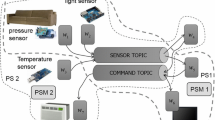Abstract
The user experience of ubiquitous environments is a determining factor in their success. The characteristics of such systems must be explored as early as possible to anticipate potential user problems, and to reduce the cost of redesign. However, the development of early prototypes to be evaluated in the target environment can be disruptive to the ongoing system and therefore unacceptable. This paper reports on an ongoing effort to explore how model-based rapid prototyping of ubiquitous environments might be used to avoid actual deployment while still enabling users to interact with a representation of the system. The paper describes APEX, a framework that brings together an existing 3D Application Server with CPN Tools. APEX-based prototypes enable users to navigate a virtual world simulation of the envisaged ubiquitous environment. The APEX architecture and the proposed CPN-based modelling approach are described. An example illustrates their use.
Chapter PDF
Similar content being viewed by others
Keywords
These keywords were added by machine and not by the authors. This process is experimental and the keywords may be updated as the learning algorithm improves.
References
CyberPsychology & Behavior 6(3/4) (2003)
Abowd, G., Hayes, G., Iachello, G., Kientz, J., Patel, S., Stevens, M., Truong, K.: Prototypes and paratypes: designing mobile and ubiquitous computing applications. IEEE Pervasive Computing 4(4), 67–73 (2005)
Braubach, L., Pokahr, A., Moldt, D., Bartelt, A., Lamersdorf, W.: Tool-supported interpreter-based user interface architecture for ubiquitous computing. In: Forbrig, P., Limbourg, Q., Urban, B., Vanderdonckt, J. (eds.) DSV-IS 2002. LNCS, vol. 2545, pp. 89–103. Springer, Heidelberg (2002)
Buchenau, M., Suri, J.: Experience prototyping. In: Proceedings Designing Interactive Systems (DIS 2000), pp. 424–433. ACM Press, New York (2000)
Davies, N., Landay, J., Hudson, S., Schmidt, A.: Rapid prototyping for ubiquitous computing — guest editors’ introduction. IEEE Pervasive Computing 4(4), 15–17 (2005)
Disz, T., Papka, M., Stevens, R.: UbiWorld: an environment integrating virtual reality, supercomputing, and design. In: Proceedings of the Heterogeneous Computing Workshop, pp. 46–59 (April 1997)
Gallasch, G., Kristensen, L.: Comms/CPN: A communication infrastructure for external communication with design/CPN. In: Jensen, K. (ed.) 3rd Workshop and Tutorial on Practical Use of Coloured Petri Nets and the CPN Tools (CPN 2001), DAIMI PB-554, Aarhus University, pp. 75–90 (2001)
Garlan, D., Siewiorek, D., Smailagic, A., Steenkiste, P.: Project Aura: toward distraction-free pervasive computing. IEEE Pervasive Computing, 22–31 (April - June 2002)
Harrison, M., Campos, J., Doherty, G., Loer, K.: Connecting rigorous system analysis to experience centred design. In: Law, E., Hvannberg, E., Cockton, G. (eds.) Maturing Usability: Quality in Software, Interaction and Value. Human Computer Interaction Series, pp. 56–74. Springer, Heidelberg (2008)
Harter, A., Hopper, A., Steggles, P., Ward, A., Webster, P.: The anatomy of a context-aware application. Wireless Networks 1, 1–16 (2001)
Jensen, K., Kristensen, L., Wells, L.: Coloured petri nets and CPN tools for modelling and validation of concurrent systems. International Journal on Software Tools for Technology Transfer (STTT) 9(3-4), 213–254 (2007)
Jensen, K., Kristensen, L.M.: Coloured Petri Nets – Modelling and Validation of Concurrent Systems. Springer, Heidelberg (2009)
Li, Y., Hong, J., Landay, J.: Topiary: a tool for prototyping location-enhanced applications. In: UIST 2004: Proceedings of the 17th Annual ACM Symposium on User Interface Software and Technology, pp. 217–226. ACM, New York (2004)
Massink, M., Duke, D., Smith, S.: Towards hybrid interface specification for virtual environments. In: Duke, D., Puerta, A. (eds.) Design, Specification and Verification of Interactive Systems 1999, pp. 30–51. Springer, Heidelberg (1999)
Navarre, D., Palanque, P., Bastide, R., Schyn, A., Winckler, M., Nedel, L., Freitas, C.: A formal description of multimodal interaction techniques for immersive virtual reality applications. In: Costabile, M.F., Paternó, F. (eds.) INTERACT 2005. LNCS, vol. 3585, pp. 170–183. Springer, Heidelberg (2005)
O’Neill, E., Lewis, D., Conlan, O.: A simulation-based approach to highly iterative prototyping of ubiquitous computing systems. In: 2nd International Conference on Simulation Tools and Techniques, ICST, pp. 1–10 (2009)
Shirehjini, A.A.N., Klar, F.: 3DSim: rapid prototyping ambient intelligence. In: Proceedings of the 2005 Joint Conference on Smart Objects and Abient Intelligence: Innovative Context-Aware Services: Usages and Technologies (2005)
Silva, J., Campos, J., Harrison, M.: An infrastructure for experience centred agile prototyping of ambient intelligence. In: Calvary, G., Graham, T., Gray, P. (eds.) Proceedings of the ACM SIGCHI Symposium on Engineering Interactive Computing Systems, pp. 79–84. ACM Press, New York (2009)
Smith, S., Duke, D., Massink, M.: The hybrid world of virtual environments. Computer Graphics Forum 18(3), C287–C307 (1999)
Westergaard, M., Lassen, K.B.: The britney suite animation tool. In: Donatelli, S., Thiagarajan, P.S. (eds.) ICATPN 2006. LNCS, vol. 4024, pp. 431–440. Springer, Heidelberg (2006)
Author information
Authors and Affiliations
Editor information
Editors and Affiliations
Rights and permissions
Copyright information
© 2010 IFIP International Federation for Information Processing
About this paper
Cite this paper
Silva, J.L., Ribeiro, Ó.R., Fernandes, J.M., Campos, J.C., Harrison, M.D. (2010). The APEX Framework: Prototyping of Ubiquitous Environments Based on Petri Nets. In: Bernhaupt, R., Forbrig, P., Gulliksen, J., Lárusdóttir, M. (eds) Human-Centred Software Engineering. HCSE 2010. Lecture Notes in Computer Science, vol 6409. Springer, Berlin, Heidelberg. https://doi.org/10.1007/978-3-642-16488-0_2
Download citation
DOI: https://doi.org/10.1007/978-3-642-16488-0_2
Publisher Name: Springer, Berlin, Heidelberg
Print ISBN: 978-3-642-16487-3
Online ISBN: 978-3-642-16488-0
eBook Packages: Computer ScienceComputer Science (R0)




